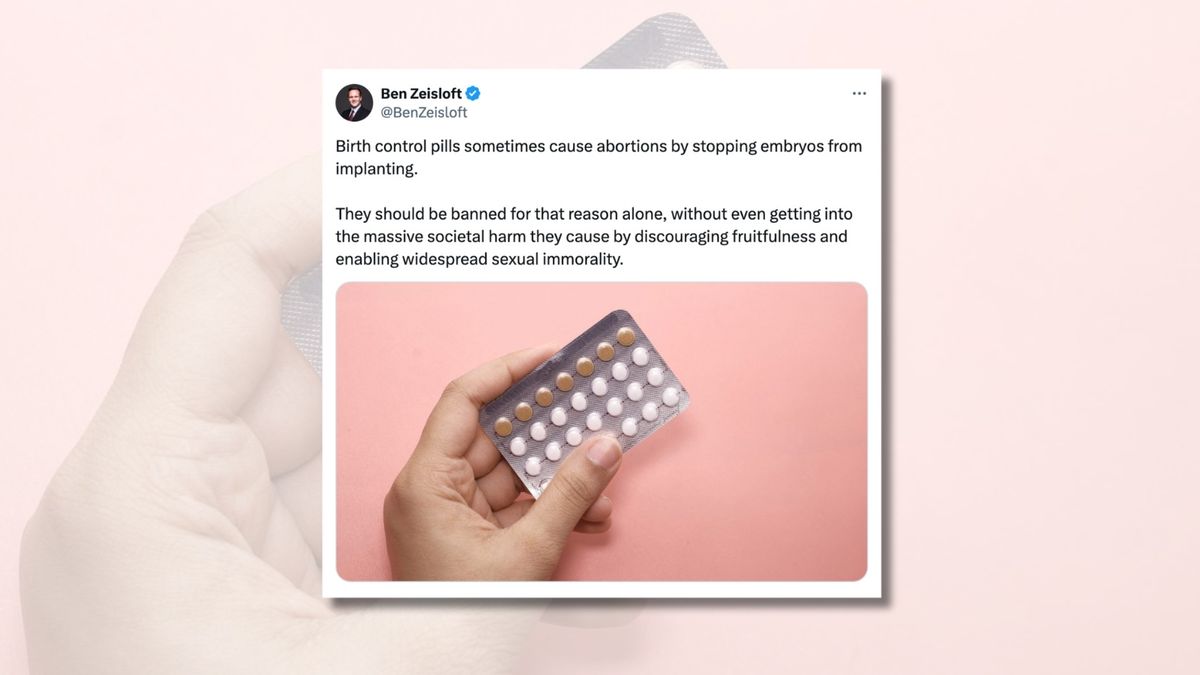On April 3, 2024, X (formerly Twitter) user Ben Zeisloft, an editor at conservative publication The Sentinel, published a post that revived a hotly debated issue related to abortion (archived):
The question of whether oral birth control causes abortion often arises in discussions about the legality of abortion. In February 2018, the group Students for Life of America posted a video on Facebook explaining how birth control provokes abortions:
Zeisloft's post received 2.9 million views. It was liked 979 times and reshared more than 1,800 times as of this writing. Abortion-rights advocates also amplified it, including Molly Jong-Fast, suggesting anti-abortion activists may come after birth control next (archived):
The Mechanism of Hormonal Birth Control
The primary mechanism of a birth control pill, otherwise known as a combined oral contraceptive, is to prevent ovulation altogether. If there's no egg, then sperm have nothing to fertilize. A secondary mechanism of the pill is to thicken the cervical mucus to prevent sperm from reaching the egg, in case ovulation occurs.
But some say that besides preventing pregnancies, birth control can also provoke abortions. This, anti-abortion activists argue, is because a third mechanism of the combined pill is to thin the uterine lining, or endometrium, making implantation of an embryo less likely. An un-implanted embryo is then expelled by the uterus as it sheds the endometrium.
The people making this claim are correct about this last mechanism. Further, the uterine lining can remain thin for a period of time after the person stops taking birth control. A 2012 study by Canadian fertility researchers showed that prolonged use of the combined oral contraceptive pill was associated with thinner endometrium, "leading to a higher cancellation rate and longer stimulation in frozen embryo transfer cycles."
This finding was confirmed by another study from the Netherlands, published in 2023. It showed "a significant association between a thin endometrial lining and the history of hormonal contraceptive use."
A thin endometrium is linked to risks for pregnancies following in-vitro fertilization (IVF), for instance, according to a 2022 study from China (emphasis ours):
"A thin endometrium may be associated with a higher incidence of preterm birth, low birth weight, and miscarriage. Therefore, embryo transfer should be performed with caution in these patients, and postponing to a later cycle with a thicker endometrium should be considered."
This is what has led anti-abortion activists to deem birth control pills "abortifacient" – causing abortion.
Other Causes of Thin Uterine Lining
There are many causes of thin endometrium, however. Anything that reduces the body's production of estrogen or slows blood flow can lead to this.
It can be the result of an illness, such as damage or scar tissue caused by past infections or surgery. Fibroids can also impede endometrial thickening. Polycystic ovary syndrome (PCOS) is linked to a thin endometrium, a 2021 Chinese study showed.
Other factors play a role. Obesity can lower the "receptivity" of the endometrium, according to this 2018 study from Italy. Further, this 2023 Polish study showed that "diet and metabolic factors" such as diabetes also make the endometrium less receptive.
A 2018 German-Austrian study carried out in the context of assisted reproduction showed that smoking was linked to thinner endometrium. "We showed that smoking has a negative effect on endometrial thickness on the day of embryo transfer," the researchers wrote. "This may help to further explain the detrimental influence of tobacco smoke on implantation and pregnancy rates during assisted reproduction therapy."
In 2017, a German study showed that an insufficient development of new blood vessels — known as angiogenesis — could result in a thinner uterine lining. "Deficient angiogenetic development may thus provide an explanation for the endometrial factor that causes infertility," the team of scientists said.
Sometimes, people must be treated with drugs that inhibit angiogenesis, as is the case for some cancers. For example, in 2006, scientists from Canada and the U.S. posited that certain herbs had this property, and should be studied in the case of cancer. The herbs they listed included Chinese wormwood, curcumin, grape seed extract, or green tea, or ginger.
The fertility drug Clomid is used to stimulate ovulation for those who have PCOS and don't always ovulate. It is also used in "minimal stimulation IVF" as an alternative to aggressive hormone treatment to stimulate the ovaries. It has several side effects, which include thinning of the uterine lining (emphasis ours):
Some women will have a thin uterine lining (endometrium) during Clomid treatment cycles. This is a result of the anti-estrogenic effect. During a natural menstrual cycle estrogen stimulates development of a thickened endometrium.
Because Clomid is anti-estrogenic it sometimes blocks the full developmental thickening process from occurring. We generally like to see in endometrial thickness of eight or more millimeters. However, sometimes the lining does not get thicker than 6 to 7 mm in Clomid cycles.
Breastfeeding after birth lowers the body's production of estrogen, and uterine lining is more often "inactive" during the lactation period, a 1976 study showed.
Even vigorous exercise can lower estrogen levels and affect the receptivity of the endometrium.
Taking the Logic Further
Many anti-abortion activists believe that conception occurs at the moment the sperm fertilizes the egg, before implantation. Anything that might expel an embryo in the days after fertilization, is, in their eyes, abortifacient. According to experts, however, abortion occurs after implantation because a person is only considered pregnant after implantation.
This raises a few logical questions. If the birth control pill is abortifacient because it causes the uterus lining to thin, are poor diets, smoking, cancer treatment, certain herbs, the fertility drug Clomid, breastfeeding, and vigorous exercise also abortifacient? If so, do anti-abortion activists believe these should be banned?
Further, frozen embryos used for IVF can be destroyed without ever being transferred into a uterus. They can also be transferred knowingly into a uterus that has a thin endometrium, and fail to implant. Do these scenarios constitute abortion?
